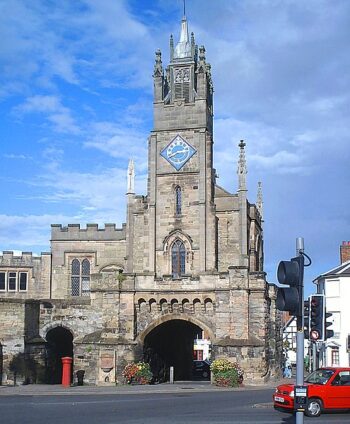
Warwick’s town walls date from Anglo-Saxon times, when the first defences were built to protect the settlement from Viking attack. The Normans extended them as part of a pattern of defences to include the new Warwick Castle, constructing stone walls and three gatehouses, of which only Westgate and Eastgate still survive.
History

The first town defences in Warwick were built by Æthelflæd, Lady of the Mercians, in 914 to protect the settlement from Viking attack. Warwick was a fortified burh, controlling a crossing over the River Avon and part of the old Roman road, the Fosse Way. It is uncertain precisely where the Anglo-Saxon defences ran, although they probably took the form of timber and earth ramparts and a protective ditch
Following the Norman invasion, the town walls were expanded to include a wider area, linking with the newly constructed Warwick Castle to the south of the town. This probably occurred through a sequence of works. Turchil of Arden was recorded as having dug a protective ditch around Warwick with gates, following orders from William the Conqueror. The town walls themselves appear to have been added later. Excavations in 1965 showed them to have been built in stone, on top of the rock face and backed with an earth rampart, with a protective ditch cut out of the underlying sandstone, up to 7.62 m (25 ft) wide and 2.7 m (9 ft) deep. By the start of the 14th century, murage grants were being given out by the Crown for the maintenance of these defences.

The walls had three main gatehouses: Northgate, Westgate and Eastgate. The south of the town was protected the River Avon and the castle; the “Great Bridge” controlled access, probably with some sort of bar or barrier. By the end of the medieval period, the walls had been largely pulled down. Northgate was destroyed by the early 16th century, and when the antiquarian John Leland visited in the 1540s, he observed that the only fragments of wall left were those alongside Westgate and Eastgate.
Westgate was in existence as early as 1126, with the chapel of St James positioned above it, paid for by Roger de Newburgh, the Earl of Warwick. It was rebuilt in 1386 by Thomas Beauchamp, the Earl of Warwick, with a ribbed-barrel vault supporting a passageway, producing its current appearance. Beauchamp gave the benefice of the chapel to the newly created Guild of St George, who extended the chapel complex to include a Great Hall and accommodation. In 1571, the Earl of Leicester acquired the buildings, creating a hospital for former soldiers.
The Westgate chapel was restored and redesigned between 1863 and 1865 by Sir Gilbert Scott. The Lord Leycester Hospital complex was extensively modernised in 1966. Extensive repairs were carried out on the gatehouse by the local council between 2018 and 2019 to replace decaying stonework, which had become dangerous.

The gatehouse at Eastgate dates back to the earliest days of the town defences, but was rebuilt in the early 15th century, with two archways, one for vehicles and another for pedestrians. A chapel, St Peter’s, was built on top of it, and acquired by the town authorities in 1576 after it fell into decay. It was was rebuilt in 1788 by Francis Hiorn, a well-known Warwick architect, in a more Gothic style. By the 19th century it was being used as a school and this continued into the late 20th century. It is currently rented out as a holiday let.
The remains of the city wall, including the gatehouses, are protected as a Schedule Monument and Grade I listed buildings.
Staying at Eastgate
Bibliography
- Creighton, Oliver and Robert Higham. (2004) Medieval Town Walls; An Archaeology and Social History of Urban Defence. Tempus: Stroud, UK.
- Turner, Hilary T. (1970) Town Defences in England and Wales. John Baker: London.
Attribution
This page includes photographs drawn from the Flickr and Cambridge University Library websites, attributed as follows: “Lord Leycester’s hospital“, author Billy Wilson, released under CC BY-NC 2.0; adapted from “John Speed’s map of Warwickshire“, photograph copyright Cambridge University Library, released under a Creative Commons Attribution-NonCommercial 3.0 Unported License (CC-BY-NC 3.0); ; “Under the Westgate”, author Elliot Brown released under CC BY 2.0.
